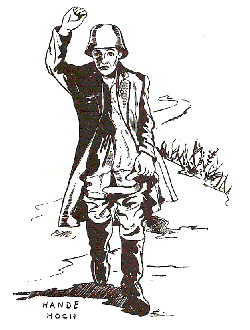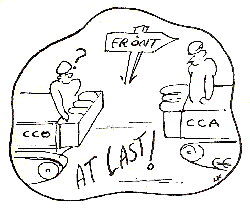| History - 49th A.I.B. - Company 'C' |
 | Index
|
| Index
| | Next |
| Next |
|
(Pages 22-24)
|
S T I L L R O L L I N G
|
|
As always we continued, unkempt, disheveled and bleary eyed from lack of sleep. Having been soaked by a drenching rain on the night of 3rd April and blessed with perhaps forty winks of sleep we arose
disgruntled and stowed our vehicles with an ominous silence. We moved out at 0500 and in quick succession passed through Salzkotten and Lippstadt, the latter having been occupied by Combat Command Reserve. On to Schmerlocke and Schallerne. We met no resistance in Schmerlocke but received enemy artillery fire and flak upon moving into and out of Schallerne. As time passed the flak became more intense causing the company to double time into the heart of the danger to prevent casualties. With C Company of the 36th Tank Battalion deployed as a base of fire
the First Platoon leading the assault, secured a foothold in the outskirts of town allowing the balance of the company to advance into the enemy strong point unmolested by small arms fire. During this skirmish a steady stream of prisoners kept pouring out only too eager to surrender. Penetrating into the interior of the town of Lohe the Third Platoon took the left flank under the leadership of First Sgt. Bottitta. The Second Platoon, under the excellent aggressiveness of Lt. Rutkowski, scoured the center of town while the
First Platoon under the guidance of T/Sgt. Frazier (now Lt.)

|
commanded the right flank. It was in this advance that Batchelor and Harrington were wounded. Pressure by now was beginning to tell on the men who were still struggling with belabored breath. How much more could a man take? The men swore aloud, cursing the bitterness of their discomfort, pledging that they would prevent their children and their children's children from ever knowing what the miseries of war held. Strange, the type of thoughts which passed through a GI's mind at such a time. With death, discomfort and stench surrounding us we thought about life, home and our girl friends or children. Do you remember such occasions? But the attack continued.
The company, with skilled precaution, reached the edge of town when all hell broke loose. Batteries of flak guns, 88's and automatic weapons fire made the Third Platoon position almost untenable until our forward artillery observer adjusted our own artillery fire on enemy positions, breaking up the counter
attack. After an all night pounding these enemy troops were in a disposition to surrender. To a casual
bystander, one having nerve enough to remain in that area, the sky appeared as brilliantly illuminated as if
a battery of searchlights were sweeping the heavens. During this counter attack the First Platoon, which
was on the right flank, was subjected to some of the artillery fire the Germans were throwing over and the
command, "Dig in" cut through the air. And dig, dig, dig they did. As for the Second Platoon, their assignment
was to remain between the two platoons as a supporting element. However, as the night wore on, it appeared as though the Second Platoon might be needed in the Third Platoon's area to assist. It was here that Smith and Mellin of the Anti Tank Platoon were wounded when S/Sgt. Butler's reconverted machine gun squad became pinned down under heavy enemy automatic fire. Here, again, First Sergeant Bottitta took command of the Third Platoon after it's loss of Lt. Kimpel and T/Sgt. Paradis, and with aggressiveness held the platoon intact to accomplish
it's mission.
|
-- 22 --
|
The following day, April 6th, the company moved into Bad Sassendorf meeting no resistance and taking approximately thirty prisoners. At 1300, C company, still attached to the 36th Tank Battalion, headed for
Soest. The plans called for us to occupy this city, but plans aren't always final. Instead we moved around
Soest from the South and West with the second platoon mounted in half-tracks following D Company of the 36th and strafing the woods en-route. After the woods were cleared, the second platoon mounted the tanks of C company of the 36th to continue the march, followed by C company of the 49th Battalion and the remainder of the tank battalion. In spite of intermittent artillery fire this task force continued in its line of march toward the next objective, the city of Ost Onner. Here every gun came into action. The two battalions, combined, blazed their way across the plains of Germany.
Meanwhile, the Trains convey was following the lead elements by only a few seconds, the only protection being furnished by a platoon of A company tanks. Spotting three enemy tanks, one a Tiger and
the others Panthers, one of the gunners screamed to anyone who could hear him in the Trains convoy, 'Get those vehicles the hell out of here. There are three enemy tanks up there'. However the narrow road was jammed and there was no turning back. "Cactus" Kyle, standing in the maintenance half-track, swung the .50 caliber machine gun around toward the three tanks and the gun spit death. This was the only heavy weapon in the Trains convoy. The tankers despite the difficulty of bringing up their tanks because of the traffic jam, eventually brought their guns to bear on the enemy. But not before tragedy had struck. Within the Trains convoy the half-track
carrying eleven engineers came into the sights of the German Tiger tank. As those
|
in the supply trucks saw the bodies of the unfortunate engineers hurtling skyward their blood
froze but if revenge is sweet, then certainly the tankers of A Company had their just share. With their concentrated fire power they poured round after round into the enemy tanks leaving them burning, torn and smoldering. Out of this chaos one German remained alive. That too was temporary. The convoy was credited with destruction of three enemy tanks, the interception of an enemy convoy consisting of approximately twelve ammunition trucks and the capture of four ambulances intact, which were used to transport prisoners. Speed, speed was the thing. Remember that one particular prisoner who had no belt on his trousers and had difficulty keeping himself in a state of decency? In fact every time a vehicle rolled by his hands went up and his pants came down.
However no resistance was encountered during the remainder of the march and shortly before dusk we entered Ost Onner, taking the enemy by surprise. Outposting the town and billeting for the night we
wondered if one night was really going to be set aside for sleeping. But the GI's who pulled two hours of
guard that night found the answer.
Then came the dawn and another day was spent slugging it out with the 'krauts'. On the zero hour, 1530, 7th April, C company was on the move again; this time moving across country into Mayicke. Little
resistance was encountered. Here the company dismounted and moved out on foot for West Onner. During this trek the first platoon met light resistance from 'burp' guns. Taking eight prisoners we sustained no casualties. Platoon positions were dug in for the night. The 'krauts' were still persistent and threw in some heavy stuff. |

|
-- 23 --

The following morning we pulled out, Ostfullen was the objective. For once the infantry went in mounted. With the exception of heavy artillery, the objective presented no problem. To our front lay the
city of Werl; the town we had been sweating out for two days. Dismounting, the company proceeded on foot with the first platoon on the left, the second on the right, and the third platoon and tanks in close support. Strangely enough no resistance was encountered on the outskirts of the town and there was very little activity encountered in the interior. Over two hundred prisoners were accounted for and several bazooka men were efficiently disposed of. For his gallantry in this engagement Pfc. Read was awarded the Silver Star. The company billeted in houses on the outskirts of town receiving occasional enemy artillery barrages throughout the night. As a result the company sustained three casualties and one case of combat fatigue. Once again the men were showing signs of strain.
Early the next morning we pulled out of Werl with the first platoon mounted on C company tanks of the 36th Tank Battalion and followed by the second and third platoons mounted in half-tracks. The 88th Cavalry had been advanced but were pulled back to the rear when advised by General Devine that no resistance was
expected. Shortly after the jump off the lead tank boarded by Lt. Frazier and part of the headquarters squad of the first platoon was hit several times and knocked out. There were three casualties among the tank crew, one being severely burned despite the efforts of Lt. Frazier to get him away from the tank and in a covered position safe from the small arms fire. As the column advanced it became vulnerable to concentrated mortar and automatic weapons fire thus leaving the infantry ineffective. An artillery preparation soon made it possible for the second platoon to attack over open ground with a platoon of tanks in close support. The first platoon
|
having reorganized, skirted the left flank and the third platoon was mounted on tanks as mobile reserve. Plunging swiftly over the objective, thirty prisoners were netted. In this attack, Sgt. Bottitta, Wright, Martin and Laws were casualties.
At that time the Russian forces were approaching Berlin from the East and the noose was getting tighter around the throats of Hitler's henchmen. 'Alles ist kaput'. Sure, we were tired but there was a certain amount of excitement which filled the air and kept us going knowing that the inevitable end of this ghastly conflict was in sight. While we were day dreaming of all the glorious things which awaited us upon our
return home the order to continue onward cracked through the air. 'Lees go! Mount up!' After days of constant movement these commands had become humdrum phrases to our ears. On to Stockum where an all around defense was organized. That night three enemy tanks sneaked in close enough to lay a direct barrage on a hedgerow around which the anti-tank platoon had dug in. In the hottest consecutive three minutes that this platoon saw in the war, Leder, a recent replacement was killed. The whole company had dug in on a wide sector expecting the worst that the SS inspired Wehrmacht could give in the way of a counterattack. When morning came, we began to relax; a few dozed in a relieved half sleep in their holes. The attack would not come now.
It was 10th April Lt. Ballinger took command of the third platoon which moved into Siddinghausen in conjunction with D company of the 36th. Moving on they entered Ostburen meeting no resistance. Late in the afternoon the company left Ostburen mounted in half-tracks and followed tank elements into Kesseburen. This involved going over open ground flanked on the left by heavy woods. Smoke was laid to cover
these woods while mounted platoons worked forward. Arriving on the edge of town it was necessary for the infantry to dismount and establish a bridgehead through a defile in the woods to the front. This was accomplished by the second platoon with the tanks moving through single file and. deploying as a base of fire for C company to continue dismounted into Kesseburen. This action involved clearing the town after darkness due to resistance by snipers. The town was outposted as security against counter attack and the company was relieved the following morning by CCA. Adamson was wounded by sniper fire in taking the town.
|
-- 24 --
|